2014 PEUGEOT 3008 weight
[x] Cancel search: weightPage 5 of 389
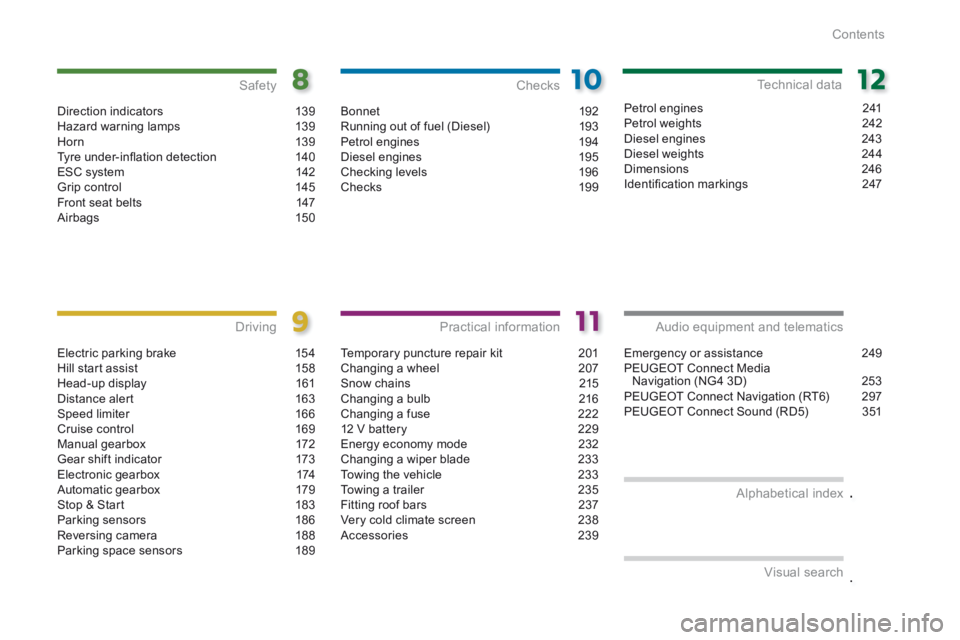
.
.
Contents
Direction indicators 139Hazard warning lamps 139H or n 13 9Tyre under-infl ation detection 140ESC system 142Grip control 145Front seat belts 147Airbags 150
Safety
Electric parking brake 154Hill start assist 158Head-up display 161Distance alert 163Speed limiter 166Cruise control 169Manual gearbox 172Gear shift indicator 173Electronic gearbox 174Automatic gearbox 179Stop & Start 183Parking sensors 186Reversing camera 188Parking space sensors 189
Driving
Emergency or assistance 249PEUGEOT Connect Media Navigation (NG4 3D) 253PEUGEOT Connect Navigation (RT6) 297PEUGEOT Connect Sound (RD5) 351
Audio equipment and telematics
Visual search
Alphabetical index
Bonnet
192Running out of fuel (Diesel) 193Petrol engines 194Diesel engines 195Checking levels 196Checks 19 9
Checks
Temporary puncture repair kit 201Changing a wheel 207Snow chains 215Changing a bulb 216Changing a fuse 22212 V battery 229Energy economy mode 232Changing a wiper blade 233Towing the vehicle 233Towing a trailer 235Fitting roof bars 237Very cold climate screen 238Accessories 239
Practical information
Petrol engines 241Petrol weights 242Diesel engines 243Diesel weights 244Dimensions 246Identifi cation markings 247
Technical data
Page 71 of 389
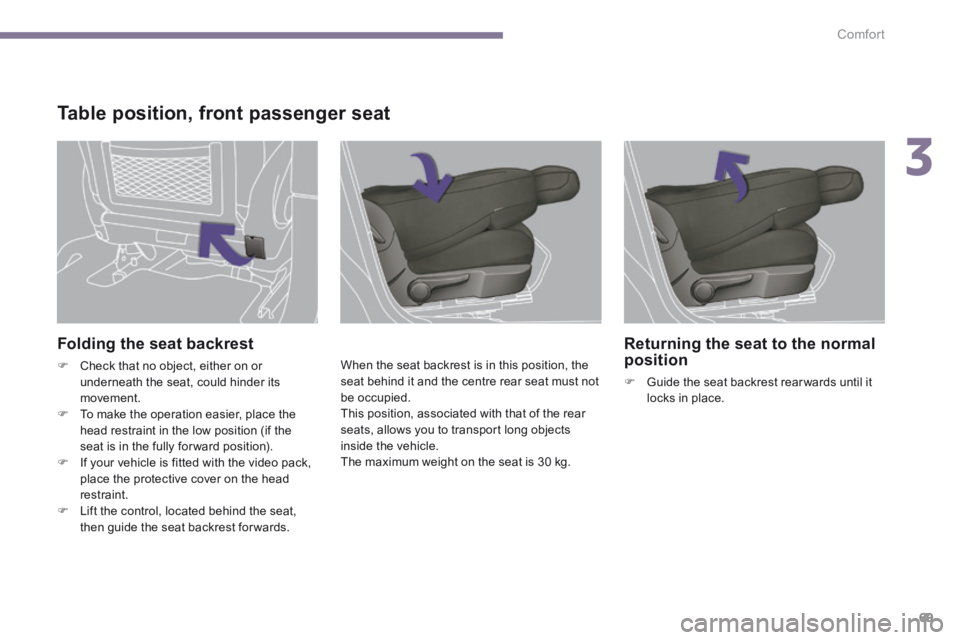
3
Comfort69
Folding the seat backrest
Check that no object, either on or underneath the seat, could hinder its movement. To make the operation easier, place the head restraint in the low position (if the seat is in the fully for ward position). If your vehicle is fitted with the video pack, place the protective cover on the head restraint. Lift the control, located behind the seat, then guide the seat backrest for wards.
When the seat backrest is in this position, the seat behind it and the centre rear seat must not be occupied. This position, associated with that of the rear seats, allows you to transport long objects inside the vehicle. The maximum weight on the seat is 30 kg.
Table position, front passenger seat
Returning the seat to the normal position
Guide the seat backrest rear wards until it locks in place.
Page 91 of 389
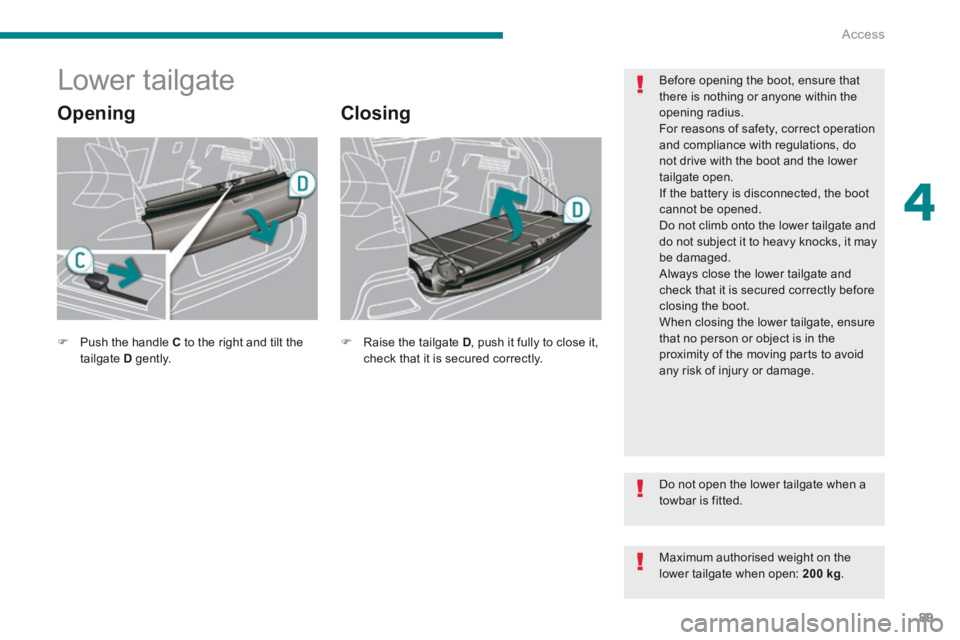
4
Access89
Lower tailgate
Opening Closing
Before opening the boot, ensure that there is nothing or anyone within the opening radius. For reasons of safety, correct operation and compliance with regulations, do not drive with the boot and the lower tailgate open. If the battery is disconnected, the boot cannot be opened. Do not climb onto the lower tailgate and do not subject it to heavy knocks, it may be damaged. Always close the lower tailgate and check that it is secured correctly before closing the boot. When closing the lower tailgate, ensure that no person or object is in the proximity of the moving parts to avoid any risk of injury or damage.
Do not open the lower tailgate when a towbar is fitted.
Maximum authorised weight on the lower tailgate when open: 200 kg .
Push the handle C to the right and tilt the tailgate D g e nt l y. Raise the tailgate D , push it fully to close it, check that it is secured correctly.
Page 127 of 389
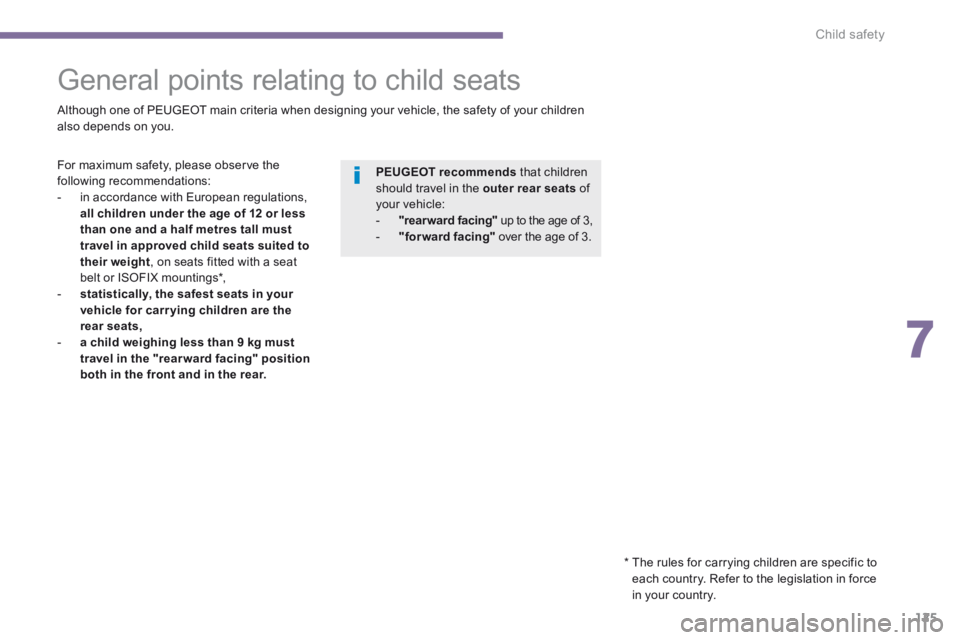
7
Child safety125
General points relating to child seats
Although one of PEUGEOT main criteria when designing your vehicle, the safety of your children also depends on you.
* The rules for carrying children are specific to each country. Refer to the legislation in force in your country.
For maximum safety, please observe the following recommendations: - in accordance with European regulations, all children under the age of 12 or less than one and a half metres tall must travel in approved child seats suited to their weight , on seats fitted with a seat belt or ISOFIX mountings * , - statistically, the safest seats in your vehicle for carr ying children are the rear seats, - a child weighing less than 9 kg must travel in the "rearward facing" position both in the front and in the rear.
PEUGEOT recommends that children should travel in the outer outer outerrear seats of your vehicle: - "rearward facing" up to the age of 3,
- "forward facing" over the age of 3.
Page 135 of 389
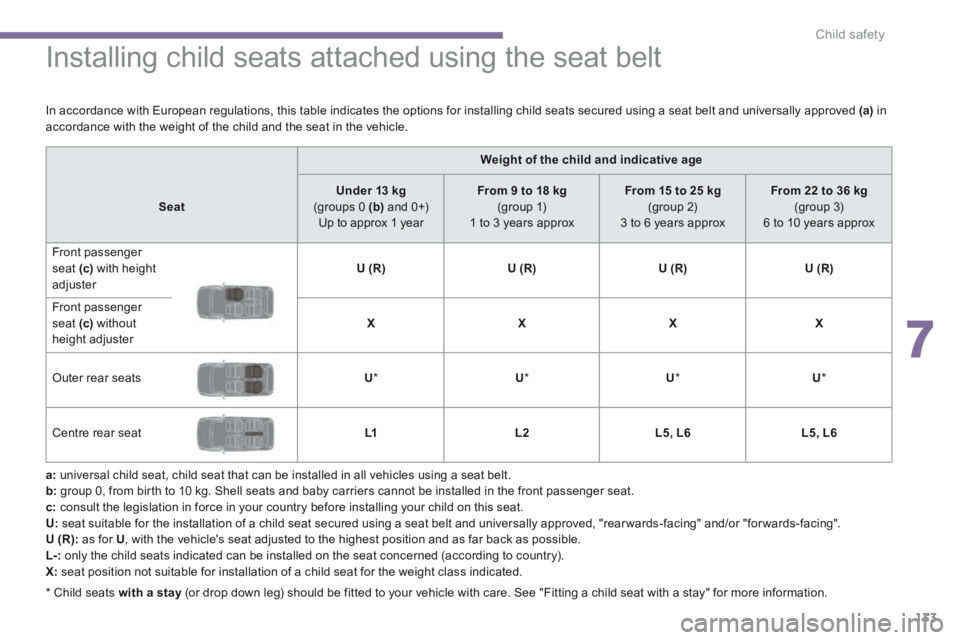
7
Child safety133
Installing child seats attached using the seat belt
a: universal child seat, child seat that can be installed in all vehicles using a seat belt. b: group 0, from birth to 10 kg. Shell seats and baby carriers cannot be installed in the front passenger seat. c: consult the legislation in force in your country before installing your child on this seat. U: seat suitable for the installation of a child seat secured using a seat belt and universally approved, "rear wards-facing" and/or "for wards-facing". U (R): as for U , with the vehicle's seat adjusted to the highest position and as far back as possible. L-: only the child seats indicated can be installed on the seat concerned (according to country). X: seat position not suitable for installation of a child seat for the weight class indicated.
In accordance with European regulations, this table indicates the options for installing child seats secured using a seat belt and universally approved (a) in accordance with the weight of the child and the seat in the vehicle.
* Child seats with a stay (or drop down leg) should be fitted to your vehicle with care. See "Fitting a child seat with a stay" for more information.
Weight of the child and indicative age
SeatUnder 13 kg (groups 0 (b) and 0+) Up to approx 1 year
From 9 to 18 kg (group 1) 1 to 3 years approx
From 15 to 25 kg (group 2) 3 to 6 years approx
From 22 to 36 kg (group 3) 6 to 10 years approx
Front passenger seat (c) with height adjuster U (R)U (R)U (R)U (R)
Front passenger seat (c) without height adjuster XXXX
Outer rear seats U * U * U * U *
Centre rear seat L1L2L5, L6L5, L6
Page 138 of 389
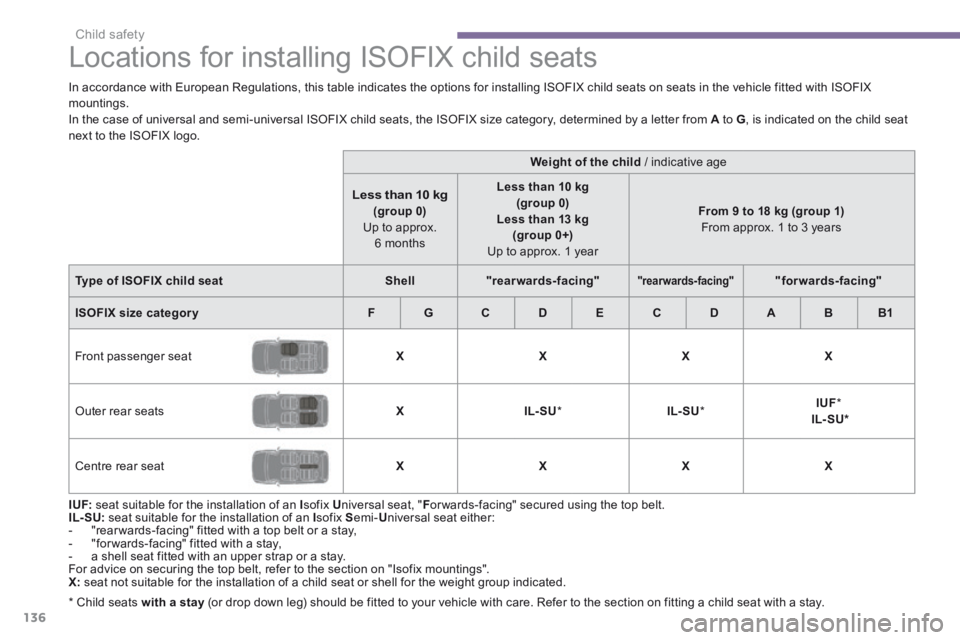
Child safety
136
Locations for installing ISOFIX child seats
I UF: seat suitable for the installation of an I sofix U niversal seat, " F or wards-facing" secured using the top belt. IL- SU: seat suitable for the installation of an I sofix S emi- U niversal seat either: - "rear wards-facing" fitted with a top belt or a stay, - "for wards-facing" fitted with a stay, - a shell seat fitted with an upper strap or a stay. For advice on securing the top belt, refer to the section on "Isofix mountings". X: seat not suitable for the installation of a child seat or shell for the weight group indicated.
In accordance with European Regulations, this table indicates the options for installing ISOFIX child seats on seats in the vehicle fitted with ISOFIX mountings. In the case of universal and semi-universal ISOFIX child seats, the ISOFIX size category, determined by a letter from A to G , is indicated on the child seat next to the ISOFIX logo.
* Child seats with a stay (or drop down leg) should be fitted to your vehicle with care. Refer to the section on fitting a child seat with a stay.
Weight of the child / indicative age
Less than 10 kg (group 0)
Up to approx. 6 months
Less than 10 kg (group 0) Less than 13 kg
(group 0+) Up to approx. 1 year
From 9 to 18 kg (group 1)
From approx. 1 to 3 years
Type of ISOFIX child seatShell"rearwards-facing""rearwards-facing" "forwards-facing"
ISOFIX size categor yFGCDECDABB1
Front passenger seat XXXX
Outer rear seats XIL- SU * IL- SU * IUF * IL- SU *
Centre rear seat XXXX
Page 236 of 389
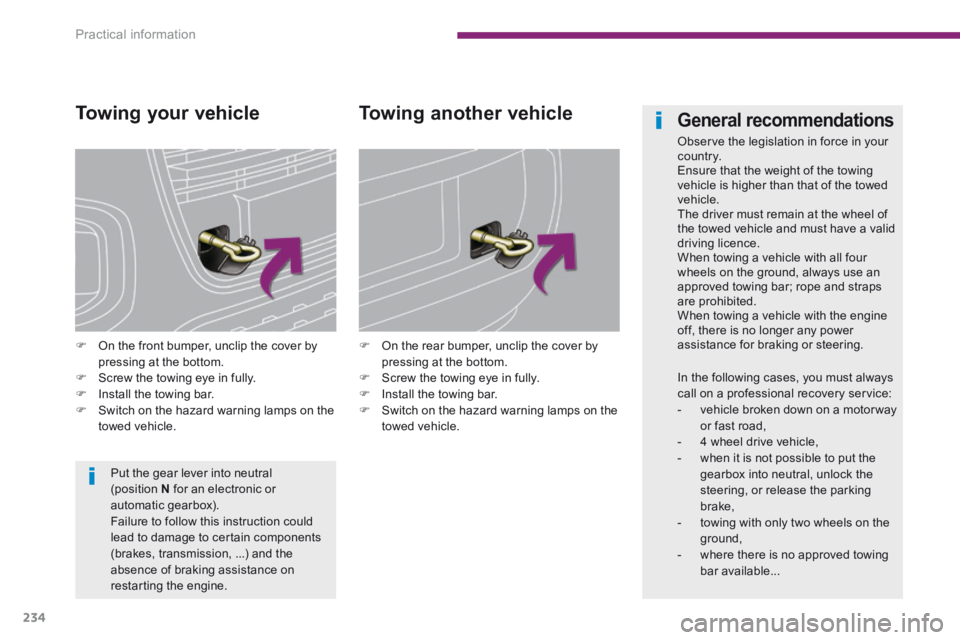
Practical information
234
Towing your vehicle
On the front bumper, unclip the cover by pressing at the bottom. Screw the towing eye in fully. Install the towing bar. Switch on the hazard warning lamps on the towed vehicle.
On the rear bumper, unclip the cover by pressing at the bottom. Screw the towing eye in fully. Install the towing bar. Switch on the hazard warning lamps on the
towed vehicle.
Towing another vehicle
Put the gear lever into neutral (position N for an electronic or automatic gearbox). Failure to follow this instruction could lead to damage to certain components (brakes, transmission, ...) and the absence of braking assistance on
restarting the engine.
General recommendations
Observe the legislation in force in your c o unt r y. Ensure that the weight of the towing vehicle is higher than that of the towed vehicle. The driver must remain at the wheel of the towed vehicle and must have a valid driving licence. When towing a vehicle with all four wheels on the ground, always use an approved towing bar; rope and straps are prohibited. When towing a vehicle with the engine off, there is no longer any power assistance for braking or steering.
In the following cases, you must always call on a professional recovery service: - vehicle broken down on a motor way or fast road, - 4 wheel drive vehicle, - when it is not possible to put the gearbox into neutral, unlock the steering, or release the parking brake, - towing with only two wheels on the
ground, - where there is no approved towing bar available...
Page 237 of 389
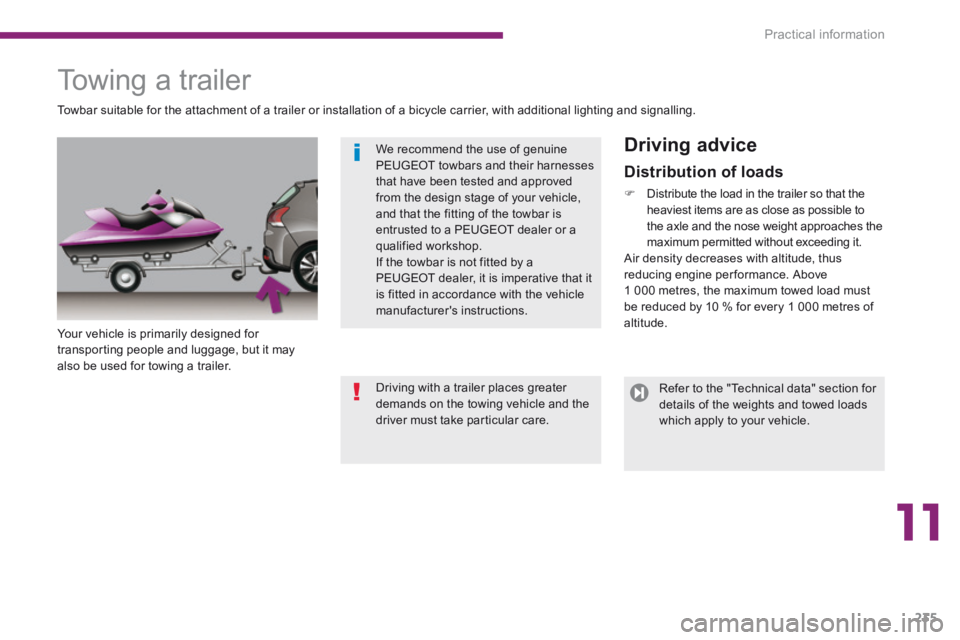
11
Practical information235
Towing a trailer
Your vehicle is primarily designed for transporting people and luggage, but it may also be used for towing a trailer.
Driving advice
Towbar suitable for the attachment of a trailer or installation of a bicycle carrier, with additional lighting and signalling.
Distribution of loads
Distribute the load in the trailer so that the heaviest items are as close as possible to the axle and the nose weight approaches the maximum permitted without exceeding it. Air density decreases with altitude, thus reducing engine performance. Above 1 000 metres, the maximum towed load must be reduced by 10 % for every 1 000 metres of altitude.
We recommend the use of genuine PEUGEOT towbars and their harnesses that have been tested and approved from the design stage of your vehicle, and that the fitting of the towbar is
entrusted to a PEUGEOT dealer or a qualified workshop. If the towbar is not fitted by a PEUGEOT dealer, it is imperative that it is fitted in accordance with the vehicle manufacturer's instructions.
Refer to the "Technical data" section for details of the weights and towed loads which apply to your vehicle.
Driving with a trailer places greater demands on the towing vehicle and the driver must take particular care.